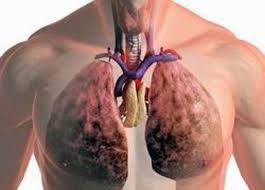Lung cancer is the uncontrolled growth of abnormal cells that start off in one or both lungs; usually in the cells that line the air passages. The abnormal cells do not develop into healthy lung tissue, they divide rapidly and form tumors.
As tumors become larger and more numerous, they undermine the lung’s ability to provide the bloodstream with oxygen. Tumors that remain in one place and do not appear to spread are known as “benign tumors”.
Malignant tumors, the more dangerous ones, spread to other parts of the body either through the bloodstream or the lymphatic system. Metastasis refers to cancer spreading beyond its site of origin to other parts of the body. When cancer spreads it is much harder to treat successfully.
Primary lung cancer originates in the lungs, while secondary lung cancer starts somewhere else in the body, metastasizes, and reaches the lungs. They are considered different types of cancers and are not treated in the same way.
According to the National Cancer Institute, by the end of 2015 there will have been 221,200 new lung cancer diagnoses and 158,040 lung-cancer related deaths in the USA.
Total deaths worldwide caused by cancer each year
- Lung cancer - 1,370,000 deaths
- Stomach cancer - 736,000 deaths
- Liver cancer - 695,000 deaths
- Colorectal cancer - 608,000 deaths
- Breast cancer - 458,000 deaths
- Cervical cancer - 275,000 deaths
The American Cancer Society says that lung cancer makes up 14% of all newly diagnosed cancers in the USA today. It adds that annually, more patients die from lung cancer alone than prostate, breast and colon cancers combined (in the USA).
Female lung cancer rates set to rise rapidly
Over the next three decades, female lung cancers will increase thirty-five times faster than male lung cancers, scientists from King’s College London reported in October 2012.
The scientists estimate that in the UK, female lung cancer deaths will reach 95,000 annually in 2040, from 26,000 in 2010 – a rise of more than 350%. Male annual lung cancer deaths will increase by 8% over the same period, to 42,000 in 2040 from 39,000 in 2010.
How is lung cancer classified?
Lung cancer can be broadly classified into two main types based on the cancer's appearance under a microscope: non-small cell lung cancer and small cell lung cancer. Non-small cell lung cancer (NSCLC) accounts for 80% of lung cancers, while small cell lung cancer accounts for the remaining 20%.
- Squamous cell carcinoma or epidermoid carcinoma. As the most common type of NSCLC and the most common type of lung cancer in men, squamous cell carcinoma forms in the lining of the bronchial tubes.
- Adenocarcinoma. As the most common type of lung cancer in women and in nonsmokers, adenocarcinoma forms in the mucus-producing glands of the lungs.
- Bronchioalveolar carcinoma. This type of lung cancer is a rare type of adenocarcinoma that forms near the lungs' air sacs.
- Large-cell undifferentiated carcinoma. A rapidly growing cancer, large-cell undifferentiated carcinomas form near the outer edges or surface of the lungs.
What causes cancer?
Cancer is ultimately the result of cells that uncontrollably grow and do not die. Normal cells in the body follow an orderly path of growth, division, and death. Programmed cell death is called apoptosis, and when this process breaks down, cancer begins to form. Unlike regular cells, cancer cells do not experience programmatic death and instead continue to grow and divide. This leads to a mass of abnormal cells that grows out of control.
Carcinogens
Carcinogens are a class of substances that are directly responsible for damaging DNA, promoting or aiding cancer. Tobacco, asbestos, arsenic, radiation such as gamma and x-rays, the sun, and compounds in car exhaust fumes are all examples of carcinogens. When our bodies are exposed to carcinogens, free radicals are formed that try to steal electrons from other molecules in the body. These free radicals damage cells and affect their ability to function and divide normally.

Genes
Cancer can be the result of a genetic predisposition that is inherited from family members. It is possible to be born with certain genetic mutations or a fault in a gene that makes one statistically more likely to develop cancer later in life. Genetic predispositions are thought to either directly cause lung cancer or greatly increase one's chances of developing lung cancer from exposure to certain environmental factors.
No comments:
Post a Comment